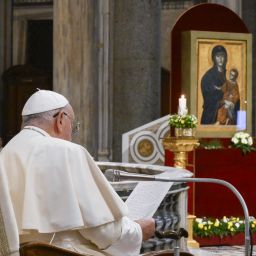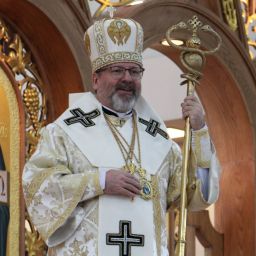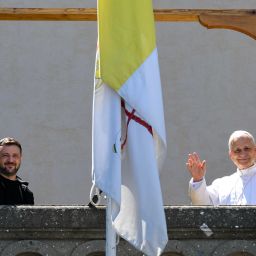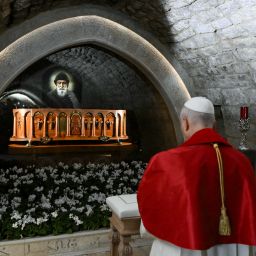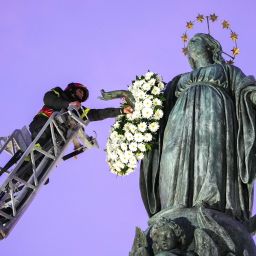By OSV News
CZESTOCHOWA, Poland — While the famed image of Our Lady of Czestochowa is known worldwide, its story is full of dramatic events worth acknowledging.
From legends about the origin of the wood on which the “Black Madonna” was written — icons are “written,” not painted — to the reason why the image is scarred — the icon mirrors Poland’s historical fate and is a spiritual refuge for Catholics from all corners of the globe.
The date of the icon’s creation is uncertain, with art historians believing it to be a Byzantine icon from the sixth or ninth centuries or from the 12th-14th centuries. It is known to have been brought to the Jasna Góra monastery in the 14th century.
The legend however attributes it to St. Luke, who supposedly wrote the icon on the table on which the Holy Family dined.
“Legend has it that the Jasna Góra icon was created on a table in the Holy Family’s home,” Father Michal Legan, a Pauline priest of Jasna Góra, told OSV News.
“Today, we know that this is certainly not true, but we can easily imagine that this icon has an impact on the lives of Polish families and families around the world, because it is hung virtually in every Polish home, somewhere where families gather and pray,” Father Legan, who heads the Polish Television Catholic newsroom, pointed out.
In fact, a table is a piece of furniture that contributed to Our Lady being saved from the horrors of German Nazi occupation of Poland.
The outbreak of the war posed a serious threat to Jasna Góra. The German Nazis understood the deep religious and cultural significance of the icon of Our Lady of Czestochowa. There was a real danger the painting would be seized, destroyed, or sold to private collectors.
Faced with this threat, the Pauline monks took a bold step: They concealed the icon in a specially prepared compartment in the top of one of the Jasna Góra library tables. Its monumental size and unassuming appearance ensured the priceless treasure went unnoticed.
The Old Library of Jasna Góra houses two unique tables crafted in the 1730s by Brother Grzegorz Wozniakowicz. They are masterpieces of woodcarving and marquetry, richly decorated with scenes of saints and made from a variety of woods with Baroque-level craftsmanship.
Their design was not only decorative but practical. The tables were built as single, nondetachable units so heavy and monumental that it was physically impossible to remove them from the library. This feature proved crucial in protecting the icon of the Black Madonna during the war.
At one point, Nazi occupiers of Poland planned to transport the tables to Dresden in Germany as valuable works of art. As the threat intensified, the icon was moved again — this time walled up in a monastery cell. It survived the darkest years of the war, though subsequent moves caused some damage that required restoration afterward.
Although the icon did not spend the entire war inside the table, its role remains significant. It was the first hiding place, a symbolic “ark” meant to protect the nation’s spiritual treasure. Today, the table is treated as a historic relic, almost as valuable as the rare books and manuscripts that surround it in the library.
“There is a beautiful symbolism in the fact that the icon, which according to legend was painted on the table of the Holy Family, was hidden during World War II from the Germans in one of the most beautiful tables that can be found in Poland and Europe,” Father Legan said.
A Pauline priest who showed OSV News the table described it as “not just a piece of furniture,” but rather “a shield, a shelter, and protection,” pointing out that “without the decision of the brothers” to hide it, “who knows what would have happened to the painting?”
The image did not escape damage throughout centuries however — with 15th-century scars making the “Black Madonna” one of the most famous Marian images in the world.
In 1430, robbers attacked the monastery on Easter, slashing and smashing the image in the Chapel of Our Lady. King Wladyslaw Jagiello ordered its restoration, and painters reassembled and repainted the board, though conservation methods were poor. The scars remain visible — either because attempts to cover them failed or, as tradition holds, they were deliberately left as a reminder of the attack.
It’s also the look of Our Lady that makes her unique, Father Legan told OSV News.
“According to St. John Chrysostom, an icon is not meant to be looked at and admired, but rather so that the person depicted on the icon can look at you,” he said.
“It is about the gaze of God, which is full of goodness and does not judge, and the gaze of the Blessed Mother, which also allows us to discover our dignity.”
While Our Lady of Czestochowa is primarily the “Queen of Poland,” her significance extends beyond the country. The icon has been venerated for centuries by the faithful of other nations. Just in 2024 alone, over 4 million pilgrims visited the shrine of Jasna Góra — a place of beloved spiritual refuge of many Polish saints, including St. John Paul II.
A special shrine in Doylestown, Pennsylvania — dubbed “American Czestochowa” — has been run by the Pauline fathers since the 1950s. It has become a pilgrimage site for Polish diaspora communities and others seeking spiritual guidance, a reflection of Jasna Góra across the Atlantic.
Cutline for featured image: An image of Our Lady of Czestochowa, known as the Black Madonna, is seen Aug. 16, 2025, at Jasna Góra in Czestochowa, Poland. Hundreds of thousands of pilgrims from all corners of Poland walk every year in August to the Marian shrine. (OSV News photo/Paulina Guzik)

